Hakone makes for the perfect little getaway from the big city. With beautiful views of Mount Fuji, countless onsens and a volcanic valley, Hakone has a lot to offer. Find out how to take the perfect day trip to Hakone from Tokyo below.
The beautiful mountain town of Hakone is located less than 100 km from Tokyo (1.5–2 hours). And with its stunning scenery, Mount Fuji views and hot springs, it makes for the perfect day trip from Japan’s capital city.
While staying overnight in Hakone is something I would highly recommend, it’s not always possible to find two days in your Japan itinerary. If you only have one day to visit Hakone, you can still make sure to visit all the main sights and make it an unforgettable day trip. We’ve got all the info you need!
For a relaxing break from busy Tokyo, check out the one-day Hakone itinerary below.
On this page
No time to read the full guide? No problem! Here’s a map with the highlights of this Hakone itinerary:
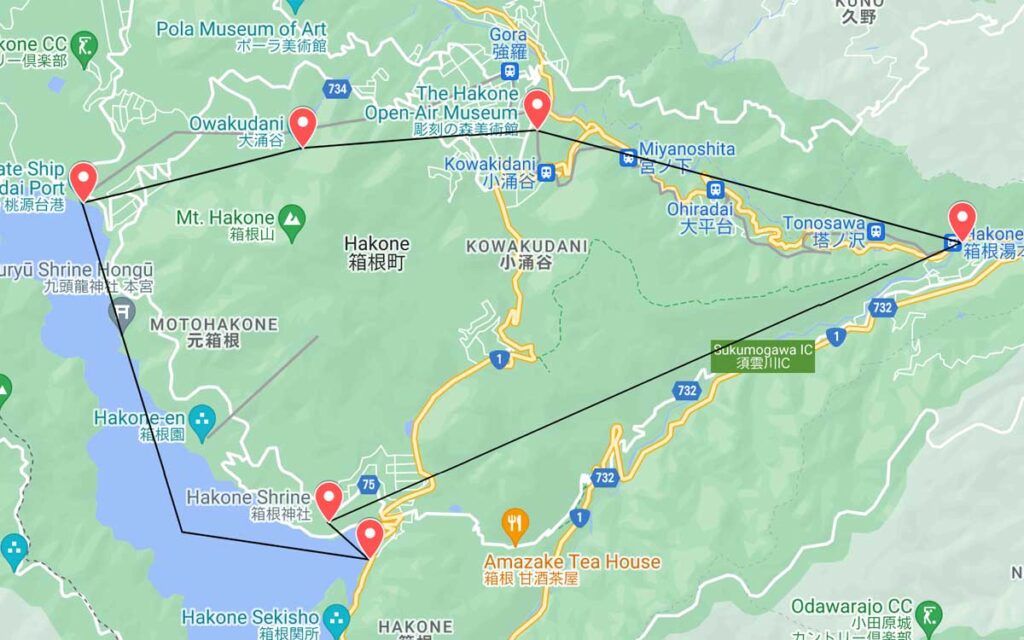
Click here for the interactive map
Here is my one day Hakone itinerary from Tokyo:
Try to get the train from Tokyo as early as possible. Since you’ll only have one day to explore Hakone, you want to make the most out of it. There are different ways to get to Hakone, depending on what passes you have (more information about the different options below), but the easiest way is by using the Hakone Free Pass.
The Hakone Free Pass is a discount pass that can help you save money (and time) while exploring Hakone. Apart from unlimited access to public transport in the Hakone area and countless discounts on museums, restaurants and onsens, the pass also gives you a return ticket from Shinjuku Station to Hakone.
You can book the Hakone Free Pass online and redeem it at Shinjuku Station on the morning of your day trip. Once you’ve got the Hakone Free Pass, you also have the option to upgrade your return ticket to the limited express Romancecar. This is essentially a faster train service and comes at a surcharge on top of the Hakone Free Pass (1,200 yen one-way).
Without the upgraded express ticket, the journey from Shinjuku to Hakone takes around two hours. With an upgrade express ticket, it takes around 80 minutes.
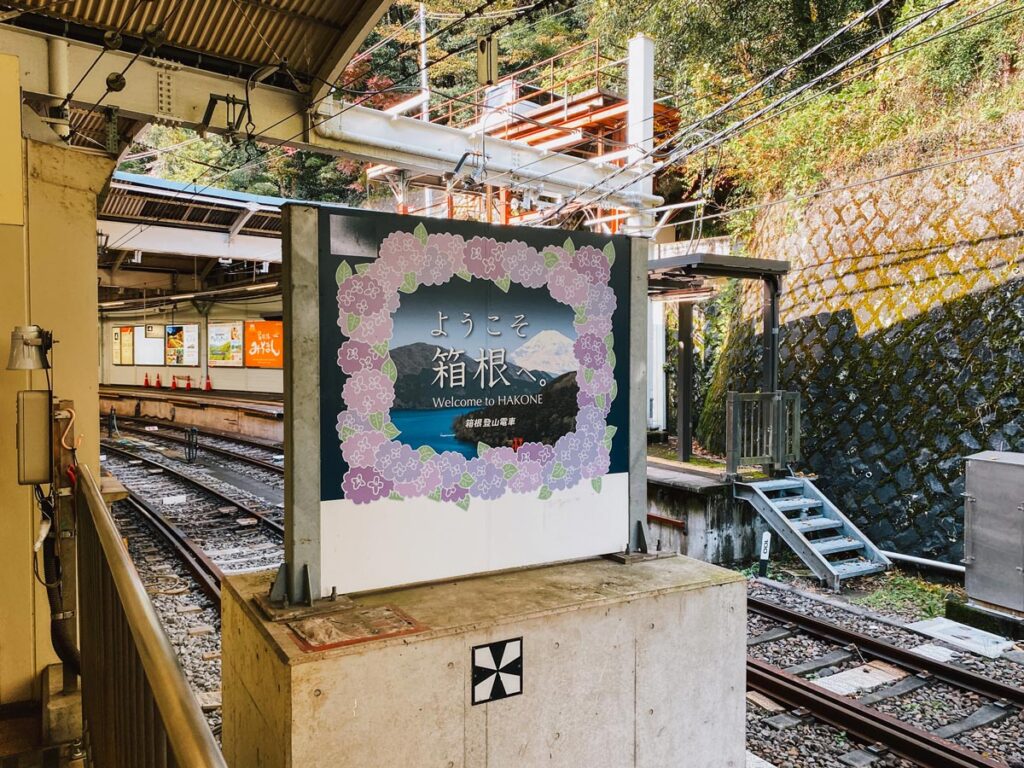
After arriving at Hakone-Yumoto Station, jump on the bus towards Lake Ashi. There are multiple bus routes that will take you there and you can use the Hakone Free Pass to ride them for free. The bus takes around half an hour.
Once arrived at Lake Ashi, you can take some time to explore. Around the lake, there are tons of opportunities for small nature hikes. But since we’re on a tight schedule, it’s best to only walk to Hakone Shrine – one of Hakone’s most famous landmarks.
The floating torii gate on Lake Ashi is probably one of the most iconic and beautiful images from Hakone. Hakone Shrine is a must-visit when in the area but prepare for queues near the torii gate (you won’t be the only one wanting to take a picture – we waited around 20 minutes).
Behind the famous torii gate, you can walk up the steps towards the main entrance of the shrine. The original shrine was built in 757 but was later relocated to where it stands today.
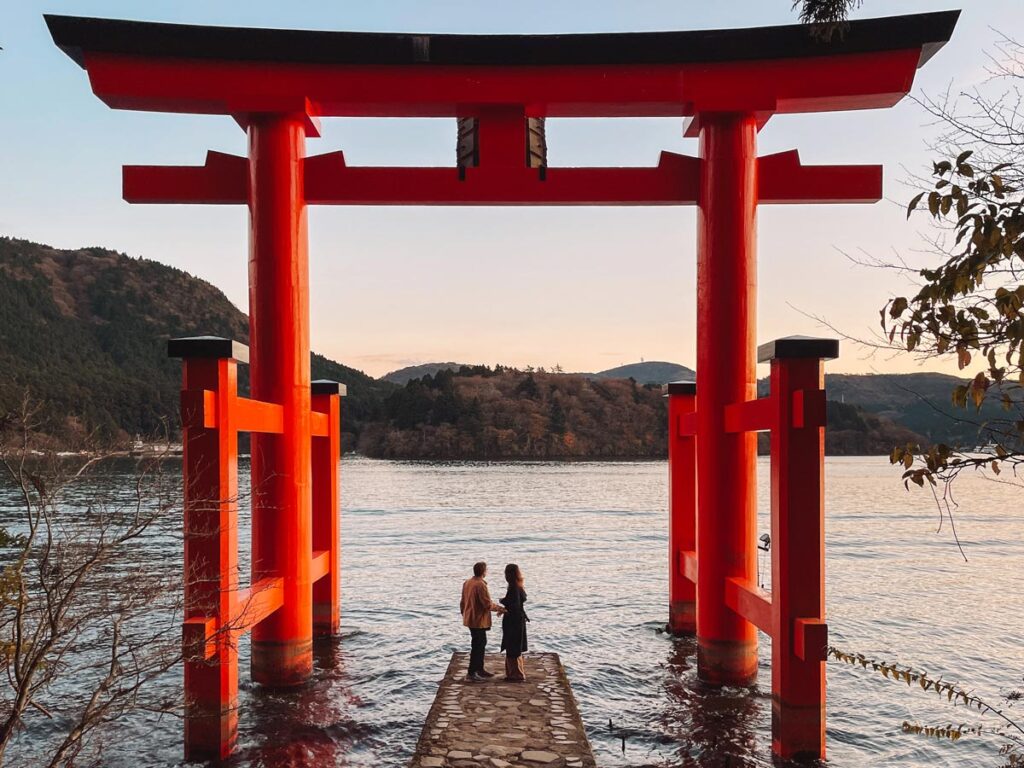
Hakone is known to be one of the best places to spot the famous Mount Fuji. Mount Fuji, or Fuji-san, is one of the things Japan is most famous for – and it’s pretty clear why. This beautiful mountain (and active volcano) has been inspiring the Japanese for centuries.
After visiting Hakone Shrine, start making your way to Moto-Hakone Port or Hakone-machi-ko.
Lake Ashi looks stunning from Hakone Shrine, but it’s even more beautiful when you’re sailing across it. Especially, when you’re doing it in style…
There are three different pirate ships (yes, pirate ships, you read that correctly) sailing across Lake Ashi, each with a unique design. The trip itself takes 25–40 minutes, depending on where you board (Hakone-machi-ko or Moto-Hakone-ko).
The trip on these pirate ships is included in the Hakone Free Pass, so you can board without having to pay for an individual ticket (unless you want to upgrade for the special room and access to the front of the ship. In my opinion, this isn’t worth it! The ticket that’s included with your Hakone Free Pass is more than good enough).
On a clear day, you can find some of the very best views of Mount Fuji from the ship. The first time we saw it from here, I teared up a little. You can also see the floating torii gate from Hakone Shrine from the ship, along with Kuzuryu-Jinja Shrine and the beautiful forest surrounding the lake.
Plus, it’s the easiest way to get to the Ropeway Station, which brings us to our next stop on this Hakone itinerary…
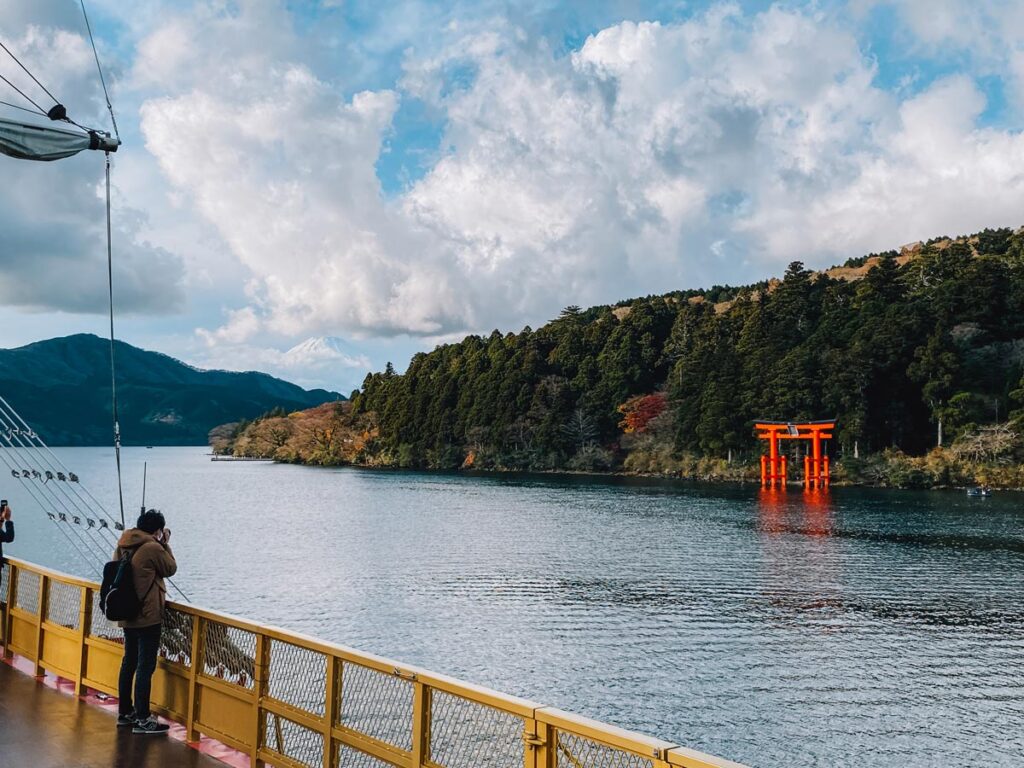
After getting off the pirate ship at Tōgendai Port, you can walk over to the Ropeway Station. Hakone’s Ropeway is also included in the Hakone Free Pass, another reason why this pass will save you so much time and money.
Stay on until you reach Owakudani Station. This should take around 30 minutes, but on a clear day, you’ll be able to see Mount Fuji and Lake Ashi. There is one stop in between, Ubako Station, which is a five-minute walk to Hotel Green Plaza Hakone. We stayed here during our trip to Hakone, but it also has a public onsen with stunning Mount Fuji views.
Once arrived at Owakudani Station, you’ll immediately see why this is called the Great Boiling Valley. When Mount Hakone erupted around 3,000 years ago, this volcanic wasteland was left behind.
The sulphurous fumes and steaming pools make for a pretty unique experience (it smells!). There are even signs that warn you of the toxic volcanic fumes.
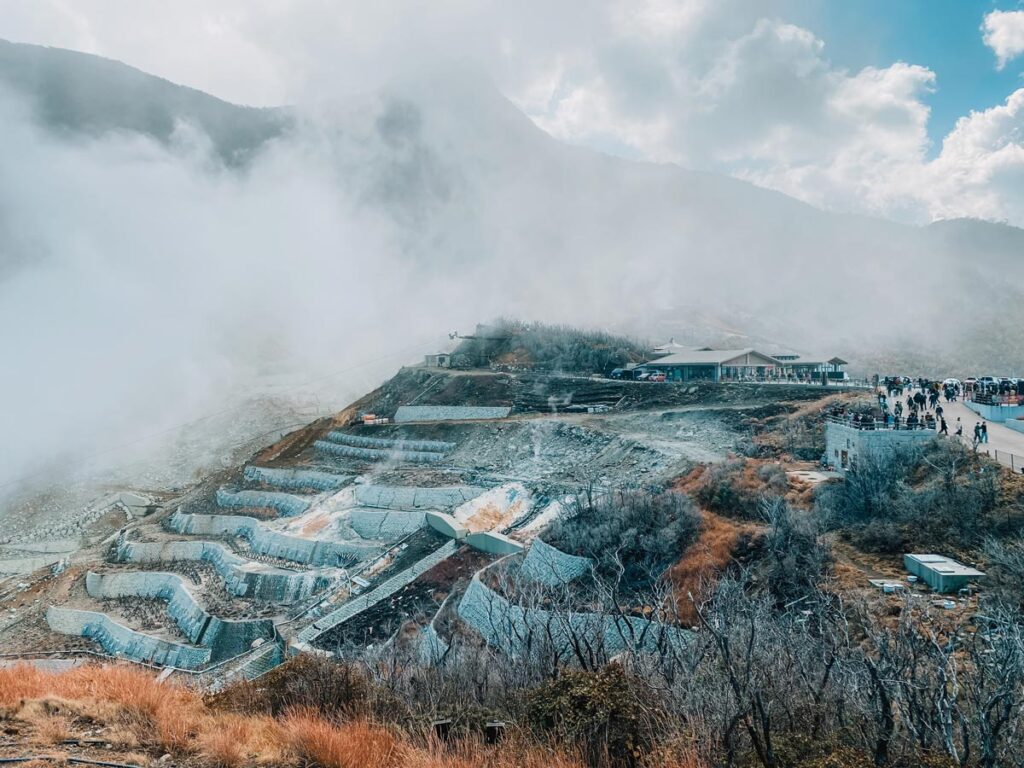
Visiting Owakudani is one of the best things to do in Hakone, but you can’t leave without trying one of the iconic black eggs (Kuro Tamago). These famous eggs are regular chicken eggs, but they’re boiled in the natural hot springs in this volcanic wasteland.
The minerals in the water turn the shell black – don’t worry, the egg inside will be untouched, it looks and tastes the same as an egg you’d boil at home. But according to local lore, eating one will add seven years to your lifespan.
Whether it’s true or false, it’s not worth the risk, is it? I ate two…
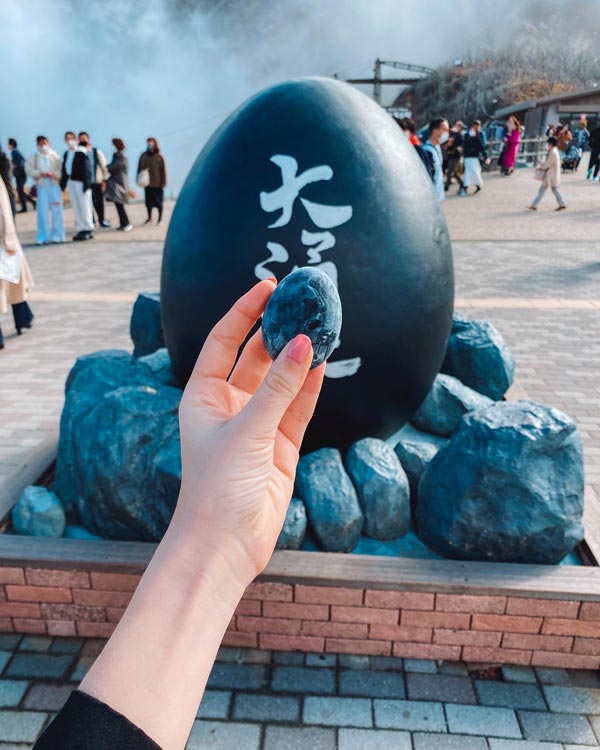
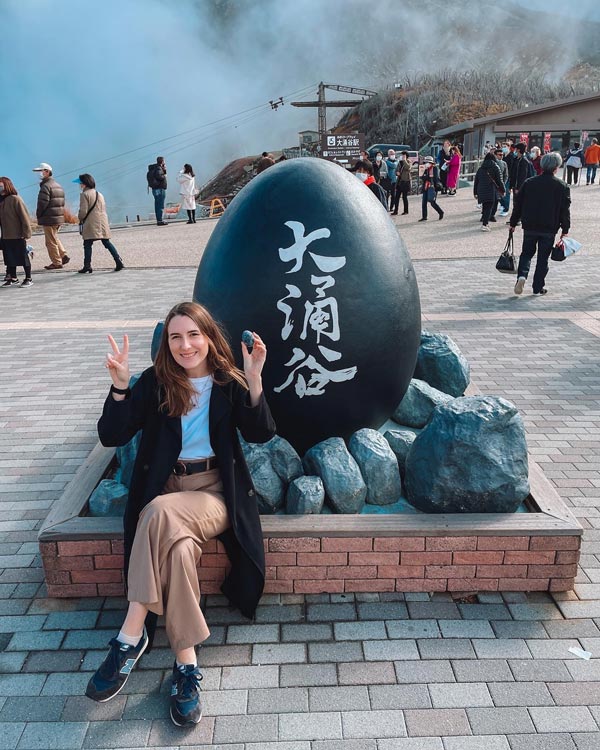
Hakone is home to quite a few museums, but Hakone Open Air Museum is one of the most popular. It’s on the Hakone Loop, making it easy to visit if you’re using the Hakone Free Pass to get around the area.
From Owakudani Station, take the ropeway to Sounzan Station. From there, you can take the Hakone Tozan Cablecar to Chokoku-no-mori Station (also included in the Hakone Free Pass). Hakone Open Air Museum is only a few minutes from here.
While the entree itself isn’t covered by the Hakone Free Pass, you will get a discount with it. The museum displays beautiful sculptures across the valley. There are multiple exhibitions, both indoors and outdoors.
After a busy day trip to Hakone, it’s time to make your way back to Tokyo again. After visiting the Open Air Museum, you can get back on the Hakone Tozan Railway and travel to Hakone-Yumoto Station. From there, the Hakone Free Pass allows you to take the train back to Shinjuku.
There are different ways to get to Hakone from Tokyo, depending on what passes you hold:
The cheapest way to get to Hakone from Tokyo is by taking the Odakyu local express train from Shinjuku. This is the route included with the Hakone Free Pass and requires a change at Odawara Station. From there, you travel onwards to Hakone-Yumoto Station.
The train does stop at every station along the way and takes around two hours, but you can enjoy some stunning views of Mount Fuji. Plus, it’s a real money-saver!
The fastest way to get to Hakone from Tokyo is by taking the Odakyu Romancecar. This direct service takes you from Shinjuku to Hakone in around 80 minutes.
If you already have purchased the Hakone Free Pass, you can pay an additional fee to upgrade to the Romancecar. You can opt for this at the Odakyu Sightseeing Service Centers
If you’re using the JR Pass to travel through Japan, you can use it to travel towards Hakone (but not all the way). From Tokyo, you can take the Shinkansen to Odawara on the JR lines. This part of the journey will be covered by the JR Pass.
From Odawara Station, you won’t be able to use the JR Pass. Instead, it’s best to pick up a Hakone Free Pass from Odawara Station – this version doesn’t include the return ticket from Shinjuku and is slightly cheaper. However, it still includes all public transport within the Hakone area and countless discounts on restaurants and museums.
No, the Hakone area is not included in the JR Pass. You can get to Odawara Station from Tokyo with the JR Pass, but from there, it’s best to use the Hakone Free Pass.
Normally, it comes with a return train ticket from Shinjuku Station to Hakone, but it’s also possible to buy it at a discounted price without this ticket. This is a good option if you hold the JR Pass during your trip to Hakone.

The Hakone Free Pass is a discount pass that can help you save money and time while exploring Hakone. Despite the name, it’s not actually “free”, but you can buy them for two or three days. Sadly, there’s no one-day equivalent of the pass.
So, what should you do when you’re going on a day trip to Hakone? I recommend still getting the two-day Hakone Free Pass.
This pass is such a big money and time saver, even when you’re only using it for a day trip. It includes a return train ticket from Shinjuku Station to Hakone, unlimited access to public transport within the Hakone area (including the sightseeing cruise and the ropeway), and countless discounts for restaurants, onsens and other attractions.
But the money saving isn’t the only big plug of this pass. It’ll save you a lot of time and hassle. Since the pass gives you access to all public transport in Hakone, you don’t have to worry about buying individual tickets or paying the correct fare. Instead, you simply flash your Hakone Free Pass and you’re good to go.
We have a full guide on the Hakone Free Pass for more information – but I highly recommend it!
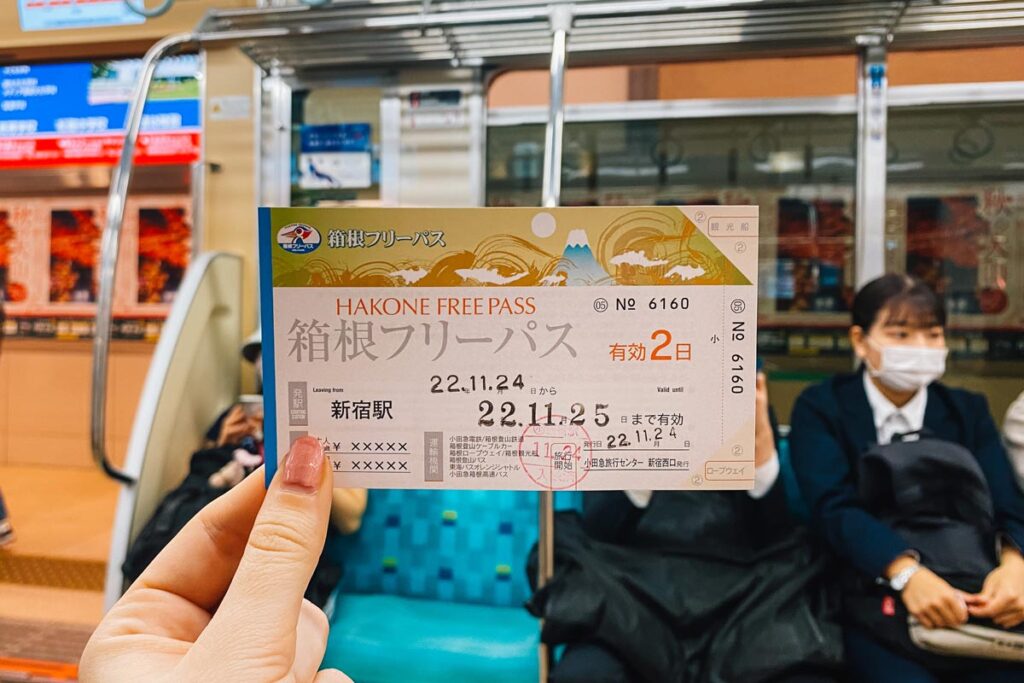
Yes, Hakone makes for a great day trip from Tokyo. It’s a lovely getaway from the big busy city, and there’s a lot you can see in a day. If you follow the Hakone Loop with the Hakone Free Pass, you should be able to see most of the area in 6–8 hours.
However, if you have enough time to add an extra day to your itinerary, I recommend staying for longer. Two or three days in Hakone is the sweet spot. Since the town is home to many onsens (Japanese hot springs), it’s an excellent opportunity to stay in an onsen hotel and try the naturally heated water for yourself.
We have a guide on where to stay in Hakone with our top hotel and Ryokan recommendations.

Weather note – the weather in Hakone can be a little temperamental. Clouds are often covering Mount Fuji, making it (almost) impossible to see. If you have a few days in Tokyo, try to be flexible when choosing your Hakone day trip.
Hakone is one of my favourite places in Japan, so I hope this guide has helped you plan your own trip there. If you’re looking for more Japan travel inspiration and advice, check out the following guides:
The beautiful mountain town of Hakone is located less than 100 km from Tokyo (1.5–2 hours). And with its stunning scenery, Mount Fuji views and hot springs, it makes for the perfect day trip from Japan’s capital city.
While staying overnight in Hakone is something I would highly recommend, it’s not always possible to find two days in your Japan itinerary. If you only have one day to visit Hakone, you can still make sure to visit all the main sights and make it an unforgettable day trip. We’ve got all the info you need!
For a relaxing break from busy Tokyo, check out the one-day Hakone itinerary below.
On this page
One Day in Hakone Map & Overview
No time to read the full guide? No problem! Here’s a map with the highlights of this Hakone itinerary:

Click here for the interactive map
Hakone Day Trip Itinerary
Here is my one day Hakone itinerary from Tokyo:
1. Take the train from Tokyo to Hakone-Yumoto Station
Try to get the train from Tokyo as early as possible. Since you’ll only have one day to explore Hakone, you want to make the most out of it. There are different ways to get to Hakone, depending on what passes you have (more information about the different options below), but the easiest way is by using the Hakone Free Pass.
The Hakone Free Pass is a discount pass that can help you save money (and time) while exploring Hakone. Apart from unlimited access to public transport in the Hakone area and countless discounts on museums, restaurants and onsens, the pass also gives you a return ticket from Shinjuku Station to Hakone.
You can book the Hakone Free Pass online and redeem it at Shinjuku Station on the morning of your day trip. Once you’ve got the Hakone Free Pass, you also have the option to upgrade your return ticket to the limited express Romancecar. This is essentially a faster train service and comes at a surcharge on top of the Hakone Free Pass (1,200 yen one-way).
Without the upgraded express ticket, the journey from Shinjuku to Hakone takes around two hours. With an upgrade express ticket, it takes around 80 minutes.

2. Take the bus to Lake Ashi
After arriving at Hakone-Yumoto Station, jump on the bus towards Lake Ashi. There are multiple bus routes that will take you there and you can use the Hakone Free Pass to ride them for free. The bus takes around half an hour.
Once arrived at Lake Ashi, you can take some time to explore. Around the lake, there are tons of opportunities for small nature hikes. But since we’re on a tight schedule, it’s best to only walk to Hakone Shrine – one of Hakone’s most famous landmarks.
3. Visit Hakone Shrine
The floating torii gate on Lake Ashi is probably one of the most iconic and beautiful images from Hakone. Hakone Shrine is a must-visit when in the area but prepare for queues near the torii gate (you won’t be the only one wanting to take a picture – we waited around 20 minutes).
Behind the famous torii gate, you can walk up the steps towards the main entrance of the shrine. The original shrine was built in 757 but was later relocated to where it stands today.

4. Spot Mount Fuji
Hakone is known to be one of the best places to spot the famous Mount Fuji. Mount Fuji, or Fuji-san, is one of the things Japan is most famous for – and it’s pretty clear why. This beautiful mountain (and active volcano) has been inspiring the Japanese for centuries.
After visiting Hakone Shrine, start making your way to Moto-Hakone Port or Hakone-machi-ko.
5. Sail Lake Ashi on a pirate ship
Lake Ashi looks stunning from Hakone Shrine, but it’s even more beautiful when you’re sailing across it. Especially, when you’re doing it in style…
There are three different pirate ships (yes, pirate ships, you read that correctly) sailing across Lake Ashi, each with a unique design. The trip itself takes 25–40 minutes, depending on where you board (Hakone-machi-ko or Moto-Hakone-ko).
The trip on these pirate ships is included in the Hakone Free Pass, so you can board without having to pay for an individual ticket (unless you want to upgrade for the special room and access to the front of the ship. In my opinion, this isn’t worth it! The ticket that’s included with your Hakone Free Pass is more than good enough).
On a clear day, you can find some of the very best views of Mount Fuji from the ship. The first time we saw it from here, I teared up a little. You can also see the floating torii gate from Hakone Shrine from the ship, along with Kuzuryu-Jinja Shrine and the beautiful forest surrounding the lake.
Plus, it’s the easiest way to get to the Ropeway Station, which brings us to our next stop on this Hakone itinerary…

6. Visit the Great Boiling Valley (Owakudani)
After getting off the pirate ship at Tōgendai Port, you can walk over to the Ropeway Station. Hakone’s Ropeway is also included in the Hakone Free Pass, another reason why this pass will save you so much time and money.
Stay on until you reach Owakudani Station. This should take around 30 minutes, but on a clear day, you’ll be able to see Mount Fuji and Lake Ashi. There is one stop in between, Ubako Station, which is a five-minute walk to Hotel Green Plaza Hakone. We stayed here during our trip to Hakone, but it also has a public onsen with stunning Mount Fuji views.
Once arrived at Owakudani Station, you’ll immediately see why this is called the Great Boiling Valley. When Mount Hakone erupted around 3,000 years ago, this volcanic wasteland was left behind.
The sulphurous fumes and steaming pools make for a pretty unique experience (it smells!). There are even signs that warn you of the toxic volcanic fumes.

7. Eat a black egg
Visiting Owakudani is one of the best things to do in Hakone, but you can’t leave without trying one of the iconic black eggs (Kuro Tamago). These famous eggs are regular chicken eggs, but they’re boiled in the natural hot springs in this volcanic wasteland.
The minerals in the water turn the shell black – don’t worry, the egg inside will be untouched, it looks and tastes the same as an egg you’d boil at home. But according to local lore, eating one will add seven years to your lifespan.
Whether it’s true or false, it’s not worth the risk, is it? I ate two…


8. Visit Hakone Open Air Museum
Hakone is home to quite a few museums, but Hakone Open Air Museum is one of the most popular. It’s on the Hakone Loop, making it easy to visit if you’re using the Hakone Free Pass to get around the area.
From Owakudani Station, take the ropeway to Sounzan Station. From there, you can take the Hakone Tozan Cablecar to Chokoku-no-mori Station (also included in the Hakone Free Pass). Hakone Open Air Museum is only a few minutes from here.
While the entree itself isn’t covered by the Hakone Free Pass, you will get a discount with it. The museum displays beautiful sculptures across the valley. There are multiple exhibitions, both indoors and outdoors.
9. Head back to Shinjuku Station
After a busy day trip to Hakone, it’s time to make your way back to Tokyo again. After visiting the Open Air Museum, you can get back on the Hakone Tozan Railway and travel to Hakone-Yumoto Station. From there, the Hakone Free Pass allows you to take the train back to Shinjuku.
How to get to Hakone from Tokyo
There are different ways to get to Hakone from Tokyo, depending on what passes you hold:
1. Odakyu local express train (Hakone Free Pass)
The cheapest way to get to Hakone from Tokyo is by taking the Odakyu local express train from Shinjuku. This is the route included with the Hakone Free Pass and requires a change at Odawara Station. From there, you travel onwards to Hakone-Yumoto Station.
The train does stop at every station along the way and takes around two hours, but you can enjoy some stunning views of Mount Fuji. Plus, it’s a real money-saver!
2. Romancecar (Hakone Free Pass upgrade)
The fastest way to get to Hakone from Tokyo is by taking the Odakyu Romancecar. This direct service takes you from Shinjuku to Hakone in around 80 minutes.
If you already have purchased the Hakone Free Pass, you can pay an additional fee to upgrade to the Romancecar. You can opt for this at the Odakyu Sightseeing Service Centers
3. JR Pass
If you’re using the JR Pass to travel through Japan, you can use it to travel towards Hakone (but not all the way). From Tokyo, you can take the Shinkansen to Odawara on the JR lines. This part of the journey will be covered by the JR Pass.
From Odawara Station, you won’t be able to use the JR Pass. Instead, it’s best to pick up a Hakone Free Pass from Odawara Station – this version doesn’t include the return ticket from Shinjuku and is slightly cheaper. However, it still includes all public transport within the Hakone area and countless discounts on restaurants and museums.
Is Hakone included in JR Pass?
No, the Hakone area is not included in the JR Pass. You can get to Odawara Station from Tokyo with the JR Pass, but from there, it’s best to use the Hakone Free Pass.
Normally, it comes with a return train ticket from Shinjuku Station to Hakone, but it’s also possible to buy it at a discounted price without this ticket. This is a good option if you hold the JR Pass during your trip to Hakone.

Is the Hakone Free Pass worth it for one day?
The Hakone Free Pass is a discount pass that can help you save money and time while exploring Hakone. Despite the name, it’s not actually “free”, but you can buy them for two or three days. Sadly, there’s no one-day equivalent of the pass.
So, what should you do when you’re going on a day trip to Hakone? I recommend still getting the two-day Hakone Free Pass.
This pass is such a big money and time saver, even when you’re only using it for a day trip. It includes a return train ticket from Shinjuku Station to Hakone, unlimited access to public transport within the Hakone area (including the sightseeing cruise and the ropeway), and countless discounts for restaurants, onsens and other attractions.
But the money saving isn’t the only big plug of this pass. It’ll save you a lot of time and hassle. Since the pass gives you access to all public transport in Hakone, you don’t have to worry about buying individual tickets or paying the correct fare. Instead, you simply flash your Hakone Free Pass and you’re good to go.
We have a full guide on the Hakone Free Pass for more information – but I highly recommend it!

Is Hakone worth a day trip?
Yes, Hakone makes for a great day trip from Tokyo. It’s a lovely getaway from the big busy city, and there’s a lot you can see in a day. If you follow the Hakone Loop with the Hakone Free Pass, you should be able to see most of the area in 6–8 hours.
However, if you have enough time to add an extra day to your itinerary, I recommend staying for longer. Two or three days in Hakone is the sweet spot. Since the town is home to many onsens (Japanese hot springs), it’s an excellent opportunity to stay in an onsen hotel and try the naturally heated water for yourself.
We have a guide on where to stay in Hakone with our top hotel and Ryokan recommendations.
Finish your Japan itinerary

Weather note – the weather in Hakone can be a little temperamental. Clouds are often covering Mount Fuji, making it (almost) impossible to see. If you have a few days in Tokyo, try to be flexible when choosing your Hakone day trip.
Hakone is one of my favourite places in Japan, so I hope this guide has helped you plan your own trip there. If you’re looking for more Japan travel inspiration and advice, check out the following guides:
